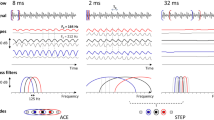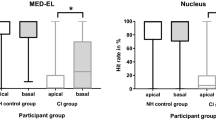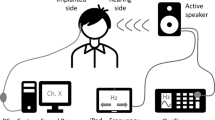Summary
BACKGROUND: The aim of this study was to determine how pitch discrimination thresholds obtained with trains of biphasic pulses in cochlear implants depend on the site (apical, middle, basal) and the rate of the stimulation. Therefore, the influence of the spectral position of a sinusoidal input signal with respect to the sub-bands (band center or overlapping area of two adjacent bands) of a running implant speech processor was investigated. Two speech coding strategies were compared, namely the CIS+ stimulation strategy, based on the continuous interleaved sampling strategy (CIS), and the fine structure strategy (FS), which also represents additional details of the temporal structure in the low frequency range of the input signal. Furthermore, it was investigated whether significant differences in pitch perception are detectable when stimulating either with 1818 pulses per second (pps) or with 3030 pps per channel. MATERIALS AND METHODS: The listening tests were conducted with seven postlingually deafened adults. All subjects were experienced users of the MED-EL COMBI 40+ or PULSARCI 100 implants. Pitch JNDs for acoustic pure tones were measured for configurations that included 1, 2 and 3 apical, middle, and basal channels respectively activated in the sound processor. The apical channels comprised channels 1, 2, and 3, the middle channels were 5, 6, and 7, and the basal channels 8, 9, and 10. Carrier pulse rates on the activated channels were 1818 pulses per second (pps) and 3030 pps, respectively. The pure tone signals were fed to the processor via direct input connection. As standard frequencies for the AFC procedure both channel center frequencies and overlapping frequencies between two adjacent channels were used. Thus, standard frequencies were 150 and 199 Hz for the apical region, 855 and 1000 Hz for the middle region, and 2237 and 2580 Hz for the basal region. After adjustment (fitting) of patient-specific processor parameters, all test stimuli were balanced in loudness. Pitch discrimination thresholds, or just noticeable differences (JNDs) in pitch, were then obtained with a two-interval two alternative forced-choice (2I-2AFC) procedure, using a three-down one-up rule for estimating the 79.4% point on the psychometric function. RESULTS: The mean discrimination thresholds at the center frequency (of 150 Hz) of the apical channel and the base rate of 1818 pps varied between 5% and 8% with FS and between 7% and 32% with CIS+ stimulation, thus showing significant differences. For test frequencies at the overlap of adjacent bands (199 Hz), JNDs with the FS strategy varied between 5% and 9% and between 6% and 9% with CIS+. Furthermore, on apical channels, and on middle channels at the filter center frequency, the higher stimulation rate of 3030 pps led to significantly better pitch discrimination. JNDs on middle channels varied between 3% and 5% with FS stimulation, and between 4% and 7% with CIS+. On basal channels, where only the effect of stimulation rate with CIS+ was investigated, no significant effect of stimulation rate was found (JNDs varied between 6% and 9%, independently of stimulation rate). CONCLUSION: In the apical region significant differences in pitch discrimination between the FS and CIS+ strategies were found. All seven subjects had better discrimination thresholds with FS stimulation, both at stimulation rates of 1818 and at 3030 pps. In the middle and basal areas only small or no differences in pitch JNDs were observed. It is hypothesized that the use of a higher stimulation rate and the application of the FS strategy in the apical region should lead to improvements in the melody recognition and tonal languages.
Zusammenfassung
HINTERGRUND: Ziel dieser Studie war es herauszufinden, ob das mit Cochlea-Implantaten erreichbare Tonhöhenunterscheidungsvermögen vom Ort der Stimulation (apikal, medial, basal) und von der Stimulationsrate abhängt. Dabei wurde auch der Einfluss der Lage der Messfrequenz innerhalb der Teilbänder (Bandmitte oder Überlappungsbereich zweier benachbarter Bänder) untersucht. Verglichen wurden zwei Sprachkodierungsstrategien, nämlich die Stimulationsstrategie CIS+, basierend auf der Continuous Interleaved Sampling-Strategie (CIS), und die Feinstruktur-Strategie (FS), welche im tieffrequenten Bereich zusätzliche Details der zeitlichen Struktur des Eingangssignals repräsentiert. Weiters wurde untersucht, ob signifikante Unterschiede in der Tonhöhenwahrnehmung feststellbar sind, wenn pro Kanal entweder mit 1818 Pulsen pro Sekunde (pps) oder mit 3030 pps stimuliert wird. MATERIAL UND METHODEN: Die Hörversuche wurden mit sieben postlingual ertaubten Erwachsenen durchgeführt. Alle Testpersonen waren erfahrene Benützer der MED-EL COMBI 40+- und PULSARCI 100-Implantate. Nach der Anpassung der patientenspezifischen Parameter wurde mit den Testpersonen ein Lautstärkenabgleich durchgeführt. Dabei wurden die generierten Sinustöne mit gleichmäßigen Frequenzschritten auf gleichen Lautstärkeeindruck eingestellt. Das Ergebnis dieses Lautstärkenabgleichs ist in die verwendete Alternative Forced Choice(AFC)-Testsoftware eingeflossen, mit der auch die differentielle Tonhöhen-Wahrnehmbarkeitsschwelle gemessen wurde. Tonhöhenunterscheidbarkeitsschwellen – auch als "Just Noticeable Differences (JNDs) in pitch" bezeichnet – wurden mit Hilfe eines mittels MATLAB entwickelten Softwareprogramms gemessen. Dieses Softwareprogramm bestimmt Unterscheidbarkeitsschwellen mittels einer "Two-Interval Two Alternative Forced-Choice(2I-2AFC)"-Prozedur unter Verwendung einer "Three-down one-up"-Regel zur Abschätzung des 79,4-%-Punktes auf der psychometrischen Funktion. ERGEBNISSE: Die Mittelwerte der differenziellen Wahrnehmbarkeitsschwelle lagen bei Verwendung der Filtermittenfrequenz als Basisfrequenz und den apikalen Kanälen bei der FS-Strategie zwischen 5 % und 8 %, bei CIS+ zwischen 7 % und 32 % und zeigten somit signifikante Unterschiede. Bei der Überlappungsfrequenz lagen die JNDs mit der FS-Strategie zwischen 5 % und 9 %, mit CIS+ zwischen 6 % und 9 %. Bei den apikalen Kanälen zeigte sich außerdem, dass eine höhere Stimulationsrate zu deutlich besseren Ergebnissen bei der Tonhöhenunterscheidung führte, ebenso wie bei den medialen Kanälen bei Filtermittenfrequenz. Hinsichtlich der Strategien ergaben sich nur bei höherer Stimulationsrate signifikante Unterschiede. Die JNDs lagen mit der FS-Strategie zwischen 3 % und 5 %, mit CIS+ zwischen 4 % und 7 %. Bei den basalen Kanälen konnte durch die Anordnung der Feinstruktur-Kanäle nur der Einfluss der Stimulationsrate bei CIS+ untersucht werden. Hierbei ergaben sich keine signifikanten Unterschiede, die JNDs lagen unabhängig von der Stimulationsrate zwischen 6 % und 9 %. SCHLUSSFOLGERUNG: Im apikalen Bereich ergaben sich zwischen den FS- und CIS+-Strategien signifikante Unterschiede in der Tonhöhenunterscheidung. Dies zeigten die Ergebnisse bei allen sieben Testpersonen in der Gruppe, sowohl bei Stimulationsraten von 1818 pps als auch bei 3030 pps. Bei den medialen und basalen Bereichen ergab sich kein merkbarer bzw. ein nur schwacher Unterschied. Die Verwendung einer höheren Stimulationsrate und die Anwendung der FS-Strategie im apikalen Bereich dürften zu Verbesserungen bei der Melodieerkennung und bei Tonalsprachen führen.
Similar content being viewed by others
Literatur
Fearn, R., Wolfe, J. (2000): Relative importance of rate and place: experiments using pitch scaling techniques with cochlear implants recipients. Ann Otol Rhinol Laryngol Suppl, 185: 51–53
Friesen, L. M. (2009): The relationship between central auditory system response and speech understanding. Can Hear Rep, 3. Canadian Academy of Audiology
Levitt, H. (1971): Transformed up-down methods in psychoacoustics. J Acoust Soc Am, 49 (No. 2, Part 2): 467–477
Nobbe, A. (2004): Pitch perception and signal processing in electric hearing: Tonhöhenwahrnehmung und Signalverarbeitung bei elektrischem Hören. Dissertation, LMU München: Medizinische Fakultät
Nobbe, A., Schleich, P., Nopp, P., Zierhofer, C. (2006). Vergleich einer Feinstruktur-Strategie mit der CIS+-Strategie bzgl. Tonhöhenunterscheidung bei MED-EL-Benutzern. 9. DGA Jahrestagung
Nobbe, A., Schleich, P., Zierhofer, C., Nopp, P. (2007): Frequency discrimination with sequential and simultaneous stimulation in MED-EL cochlear implants. Acta Otolaryngol, 127: 1266–1272
Wilson, B. S., Finley, C. C., Lawson, D. T., Wolford, R. D., Eddington, D. K., Rabinowitz, W. M. (1991): Better speech recognition with cochlear implants. Nature, 352 (6332): 236–238
Wilson, B. S., Lawson, D. T., Finley, C. C., Wolford, R. D. (1991): Coding strategies for multichannel cochlear prostheses. Am J Otol, 12 (Suppl): 56–61
Wilson, B. S., Finley, C. C., Lawson, D. T., Zerbi, M. (1997): Temporal representations with cochlear implants. Am J Otol, 18 (6 Suppl): S30–S34
Zeng, F. G. (2002): Temporal pitch in electric hearing. Hear Res, 174: 101–106
Zierhofer, C. (2001): Electrical nerve stimulation based on channel-specific sequences. World Patent WO 01/13991 A1
Zierhofer, C. M. (1999): Electrical nerve stimulation based on channel specific sampling sequences. Patent US application60/150.773
Zierhofer, C. M., Hochmair-Desoyer, I. J., Hochmair, E. S. (1995): Electronic Design of a Cochlear Implant for Multichannel High-Rate Pulsatile Stimulation Strategies. IEEE Tran Rehabil Eng, 3 (1): 112–116
Author information
Authors and Affiliations
Rights and permissions
About this article
Cite this article
Simonyan, A. Einfluss der Sprachkodierungsstrategien auf das Tonhöhenunterscheidungsvermögen von Cochlea-Implantat-Trägern in Abhängigkeit vom Stimulationsort und von der Stimulationsrate. Elektrotech. Inftech. 129, 102–106 (2012). https://doi.org/10.1007/s00502-012-0084-2
Received:
Accepted:
Issue Date:
DOI: https://doi.org/10.1007/s00502-012-0084-2




